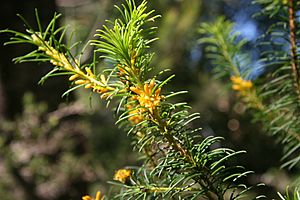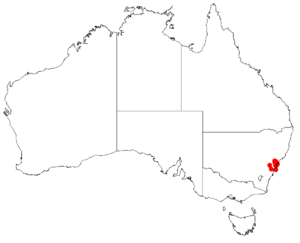Persoonia isophylla facts for kids
Quick facts for kids Persoonia isophylla |
|
|---|---|
 |
|
| Persoonia isophylla at the Australian Reptile Park | |
| Scientific classification | |
| Genus: |
Persoonia
|
| Species: |
isophylla
|
 |
|
| Occurrence data from Australasian Virtual Herbarium | |
Persoonia isophylla is a special plant that belongs to the plant family called Proteaceae. It grows only in New South Wales, Australia. This plant is a shrub that can stand tall or spread out. It has soft leaves that look a bit like pine needles. It also has groups of pretty yellow flowers shaped like tubes.
This plant is similar to another species called P. pinifolia. However, P. pinifolia flowers have small leaves at their base. P. isophylla flowers have full-sized leaves at their base. These two plants sometimes grow near each other. But it's rare for them to create hybrid plants.
What Does Persoonia isophylla Look Like?
Persoonia isophylla is a shrub that can grow from about 0.3 to 1.5 meters (1 to 5 feet) tall. It has smooth bark. Its leaves grow one after another along the stem. They are narrow and shaped like cylinders. Each leaf is about 12 to 30 millimeters (0.5 to 1.2 inches) long. They are also very thin, about 0.5 millimeters (0.02 inches) wide. When the leaves are fully grown, they are smooth and hairless.
The flowers grow in groups at the ends of the branches. Each group can have between ten and seventy flowers. The whole group of flowers has a stalk that is 5 to 90 millimeters (0.2 to 3.5 inches) long. Each individual flower has a tiny stem, called a pedicel, up to 1.5 millimeters (0.06 inches) long. A full-sized leaf grows at the base of the flower group. This leaf keeps growing even after the plant flowers.
Each flower has four yellow parts called tepals. These tepals are like petals and sepals combined. They are 7 to 8 millimeters (0.28 to 0.31 inches) long. They are joined at the bottom, but their tips curl back. In the center of the flower is a style, which is part of the plant's reproductive system. Four yellow anthers surround the style. Anthers hold pollen. They are also joined at the base with their tips curled back. This makes the flower look like a cross when you look at it from the end.
Persoonia isophylla flowers bloom from January to July. After flowering, the plant produces fruit. These fruits are smooth, green, and usually have reddish-purple spots. They are a type of fruit called a drupe, like a peach or a plum.
How Persoonia isophylla Got Its Name
The scientific name Persoonia isophylla was first officially described in 1991. This was done by two scientists, Peter H. Weston and Lawrie Johnson. They studied a plant sample found at Peats Ridge, New South Wales. Their description was published in a scientific journal called Telopea.
The second part of the name, isophylla, comes from Ancient Greek words. The word isos means "equal," and phyllon means "leaf." This name was chosen because the groups of flowers on this plant have full-sized leaves at their base.
Where Does Persoonia isophylla Grow?
This type of persoonia plant grows in sandy soils. These soils come from Sydney sandstone. You can find it at elevations up to 250 meters (820 feet) above sea level. It grows in the area between Gosford and Frenchs Forest, New South Wales.

